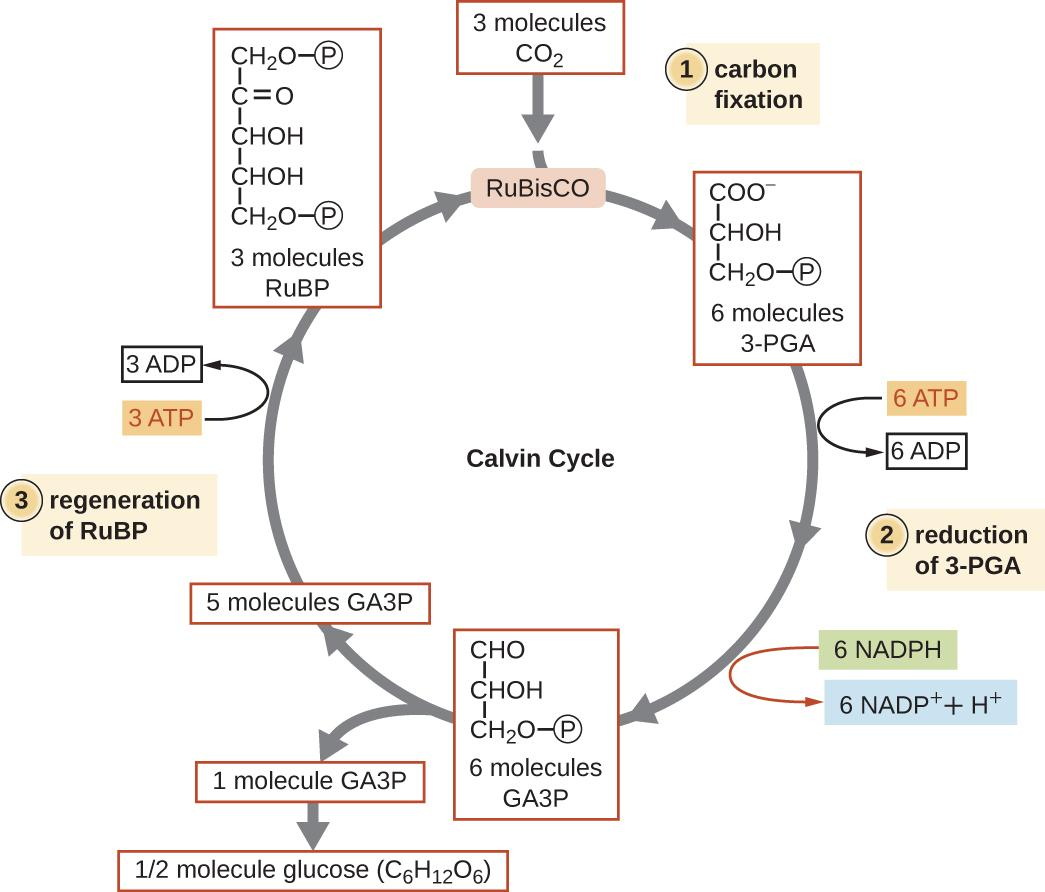
Which one of the following is represented by the Calvin cycle?
A. Reductive carboxylation
B. Oxidative carboxylation
C. Photophosphorylation
D. Oxidative phosphorylation
Answer
560.7k+ views
Hint: There are two stages of photosynthesis, light-dependent reaction - as the name suggests, these require light and occur mainly during the day. Reactions are independent of light - also known as dark reactions or the Calvin cycle or C3 cycle. This reaction occurs both in the presence and without sunlight.
Complete answer: The Calvin cycle refers to the light-free reaction in photosynthesis that takes place in three key steps. Although the Calvin cycle is not directly dependent on light, it is indirectly dependent on light, because the required energy carriers (ATP and NADPH) are the products of light-dependent reactions.

The Calvin cycle is classified into three phases.
1. The first phase is carboxylation, in which RuBP is converted into two 3-carbon compounds.
2. The next phase is a reduction, the 3-PGA molecule, made by fixing carbon, is converted into a regular sugar molecule – glucose.
3. The final stage is regeneration, a complex process requiring ATP. At this stage, some G3P molecules are used to make glucose while others are recycled to regenerate RuBP acceptors. So, the first two phases represent the reductive carboxylation.
Thus, option (A) is correct.
Note: RuBP is one of the organic substances that occurs in photosynthesis. Photosynthesis is a biochemical process that occurs in all green plants or autotrophs that produce organic molecules of carbon dioxide. This organic molecule contains a lot of carbon-hydrogen (C-H) bonds and is greatly reduced compared to carbon dioxide.
Complete answer: The Calvin cycle refers to the light-free reaction in photosynthesis that takes place in three key steps. Although the Calvin cycle is not directly dependent on light, it is indirectly dependent on light, because the required energy carriers (ATP and NADPH) are the products of light-dependent reactions.

The Calvin cycle is classified into three phases.
1. The first phase is carboxylation, in which RuBP is converted into two 3-carbon compounds.
2. The next phase is a reduction, the 3-PGA molecule, made by fixing carbon, is converted into a regular sugar molecule – glucose.
3. The final stage is regeneration, a complex process requiring ATP. At this stage, some G3P molecules are used to make glucose while others are recycled to regenerate RuBP acceptors. So, the first two phases represent the reductive carboxylation.
Thus, option (A) is correct.
Note: RuBP is one of the organic substances that occurs in photosynthesis. Photosynthesis is a biochemical process that occurs in all green plants or autotrophs that produce organic molecules of carbon dioxide. This organic molecule contains a lot of carbon-hydrogen (C-H) bonds and is greatly reduced compared to carbon dioxide.
Recently Updated Pages
Master Class 11 Economics: Engaging Questions & Answers for Success

Master Class 11 English: Engaging Questions & Answers for Success

Master Class 11 Social Science: Engaging Questions & Answers for Success

Master Class 11 Biology: Engaging Questions & Answers for Success

Class 11 Question and Answer - Your Ultimate Solutions Guide

Master Class 11 Business Studies: Engaging Questions & Answers for Success

Trending doubts
10 examples of friction in our daily life

One Metric ton is equal to kg A 10000 B 1000 C 100 class 11 physics CBSE

Difference Between Prokaryotic Cells and Eukaryotic Cells

1 Quintal is equal to a 110 kg b 10 kg c 100kg d 1000 class 11 physics CBSE

Explain zero factorial class 11 maths CBSE

What is a periderm How does periderm formation take class 11 biology CBSE




